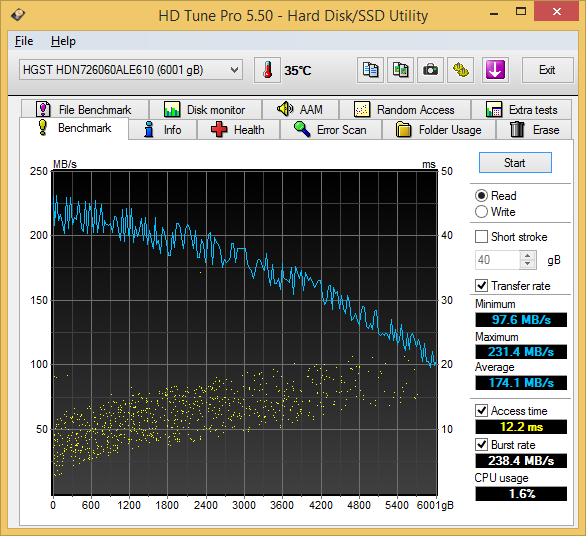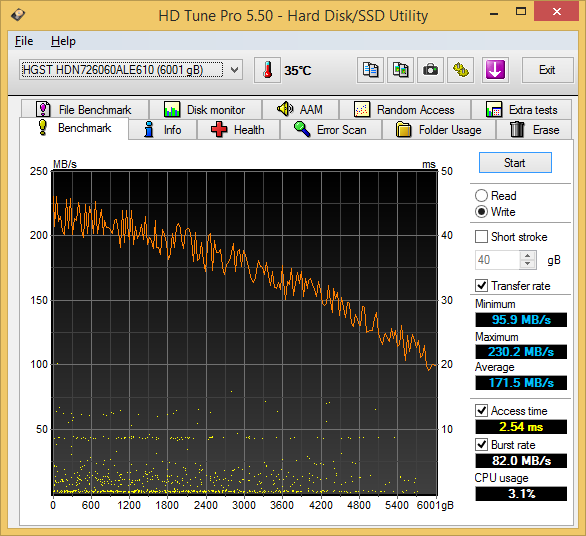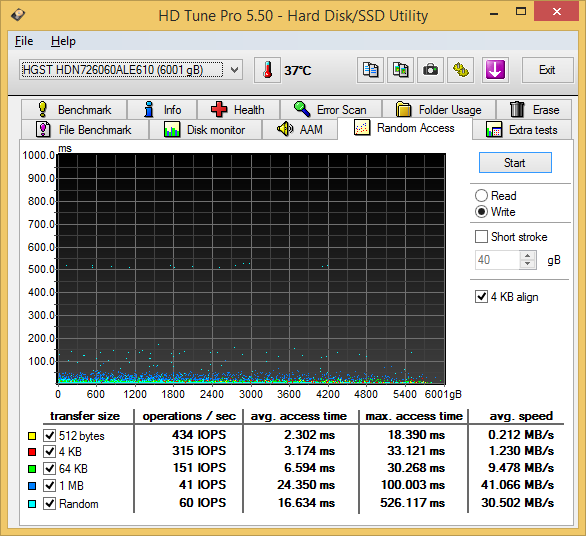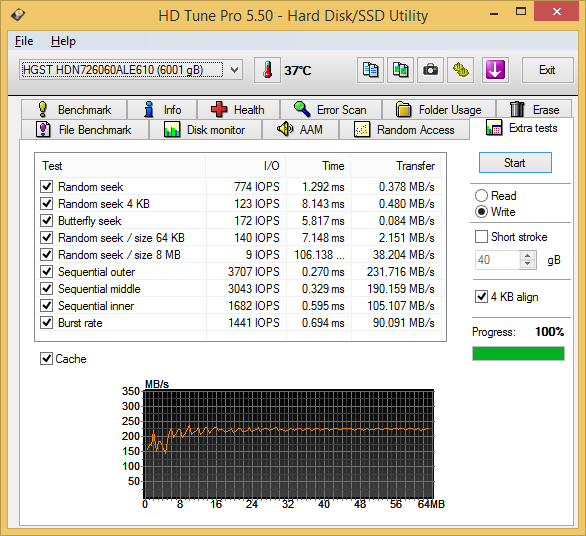HGST Deskstar NAS 6 TB Review
by Ganesh T S on December 23, 2014 11:00 AM ESTPerformance - Raw Drives
Prior to evaluating the performance of the drives in a NAS environment, we wanted to check up on the best-case performance by connecting one of them directly to a SATA 6 Gbps port. Using HD Tune Pro 5.50, we ran a number of tests on a raw drives. The following screenshots present the results for the HGST Deskstar NAS. Corresponding images for similar drives that have been evaluated previously are also provided in the drop-down box for easy comparison.
Sequential Reads

Sequential Writes

Random Reads

Random Writes

Miscellaneous Reads

Miscellaneous Writes











36 Comments
View All Comments
MamiyaOtaru - Tuesday, December 30, 2014 - link
it's mostly the "our" that immediately precedes it. Seems like it could be interpreted a couple ways. seems like it's a molehill though hehjardows2 - Wednesday, December 24, 2014 - link
Great. Now every article comments section will be descending into a "anandtech is a horrible site now that they were bought by Purch." If this is such a horrible thing, just leave. Let those of us who still enjoy Anandtech be a part of the community, and make our own decisions if the quality changes over the next couple of years.I don't look to the comments section of an article to see the bickering of the business policies of the site. I want to see comments about the product being reviewed or the news being reported.
edzieba - Wednesday, December 24, 2014 - link
Nope. Western Digital acquired Hitachi's 2.5" drive division. Toshiba acquired Hitachi's 3.5" drive division.Guspaz - Thursday, December 25, 2014 - link
HGST is a wholly owned subsidiary of Western Digital, not Toshiba. While HGST did divest some assets to Toshiba relating to 3.5" drives, the company itself went to Western Digital, and never stopped making 3.5" drives.Nocturnal - Wednesday, December 24, 2014 - link
I do have a question, how much does that server run if someone was to purchase it put together like that?akula2 - Saturday, January 3, 2015 - link
The expensive component would be buying HDDs. E.g., for the latest requirement I should go for at least 12 HDDs (RAID 6, so I get 10). Now, each HDD will cost not less than $400 for sure.You can building you own custom NAS Server once you get a solid case with many HDD drive mounts. E.g., Cooler Master got Stacker 935. One can easily stuff 16 HDDs (RAID 6 max. limit) in that case by buying additional caddies. Not expensive at all.
Mobo? Go only for Server-grade model like Asrock C226M WS micro ATX board + DDR3 16GB 1600 MHz ECC (unbuffered) RAM.
CPU? For that HDD volume, I can go for Core i3-4360T or Xeon E3 V3 processor. Both support ECC RAM.
akula2 - Saturday, January 3, 2015 - link
I forgot to add -- you'll need to buy a PCIe RAID card too.It will cost $300 for a good model, say a LSI 12Gb/s MegaRAID SATA+SAS RAID controller card.
Note that 4360T has low TDP of 35W only.
iAPX - Wednesday, December 24, 2014 - link
I like to see the NAS performances in RAID-5, they are just lulz!When will NAS performance be checked with 10Gb Ethernet link?!?
100MB/s or 120MB/s is what I expect from a single 2.5inch USB3 drive, not on a NAS that cost many grands!
Maybe it would be interesting to benchmark them on a Promise Pegasus2 R4, where you could obtain 5X to 6X more performances on the same hard drive through thunderbolt, to show their real potential???
Integr8d - Wednesday, December 24, 2014 - link
It just depends on the model of NAS they use for review. Synology, QNAP, etc all have models w/ 10Gig-E or slots for 10gig nics. Some have dual slots.The Promise R4 is a different class of product. And Thunderbolt is irrelevant. All of these tests could've been done on a single SATA3 interconnect. 6Gbps is well-more than a single one of these drives will make use of (or, if we're talking external, the 5Gbps of USB3).
ganeshts - Wednesday, December 24, 2014 - link
The whole point of a NAS is simultaneous multi-client access. A Thunderbolt peripheral or a 2.5" USB 3 drive is not geared for that purpose.Home and power users run NAS units with two GbE ports link-aggregated.
As mentioned in the review, the main difference between the drives start to appear in the form of differing average response times as the number of clients increase. Please check the multi-client CIFS access section.
10 GbE is yet to go mainstream outside of SME environments. But, rest assured, we are looking at 10 GbE for our SSDs in NAS units evaluation.